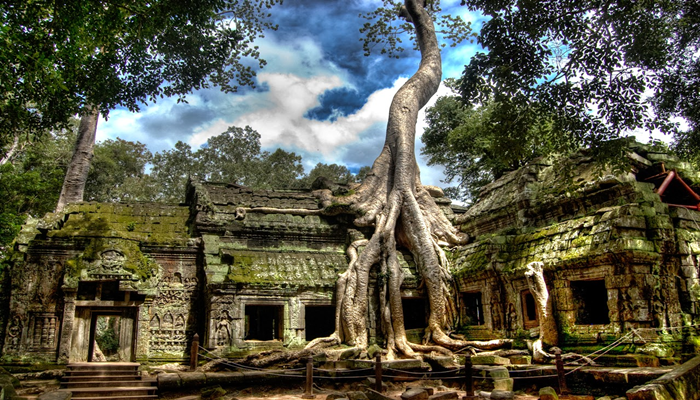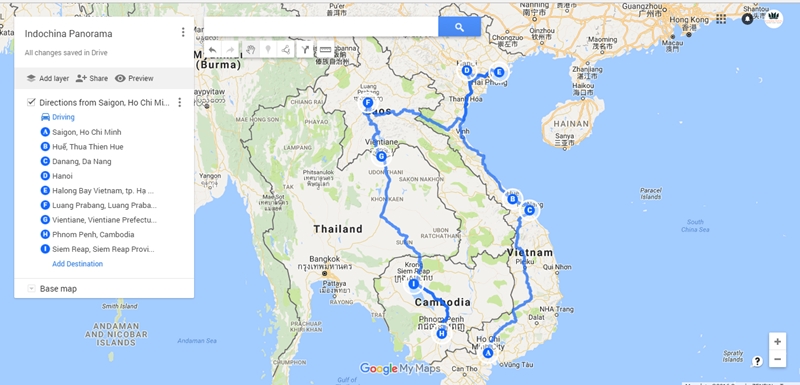Vietnam – Cambodia 15 days

This memorable journey visits the main highlights of Indochina, including enchanting towns, bustling cities, historic temples, ancient monuments and spectacular scenery.
We’ll be greeted upon arrival and transferred to the hotel for check-in and tour briefing. We’ll take an orientation tour and a chance to acclimatize ourselves if time permits. A welcome dinner awaits us tonight.
This morning we travel to Cu Chi to explore the legendary network of underground combat tunnels. This incredible system, covering almost 250km in length, served as communication routes, storage facilities, hospitals and living quarters for Vietnamese fighters throughout the wartime. Known as the "Iron Triangle" during the war of the 60's, the story of Cu Chi is one of struggle, determination against all odds, and eventual victory. Now the tunnels are a major site of interest for tourists and historians, and those interested in Vietnam's military history. Following lunch, we return to town and continue sightseeing with the best known sites in the very center of Saigon such as the Reunification Palace, the War Museum, the Notre Dame Cathedral, the Post Office, the Opera House, Ben Thanh Market, etc.
After breakfast we leave the hustle and bustle of Saigon behind and travel into the Mekong Delta, a world that lives and works on the waters. Arriving in My Tho, 80 km from Saigon, we get on a boat trip on the Mekong River, then into a palm-shaded canal towards an island. Disembark and roam into the insular village to see production of handicrafts and candy from coconut, taste freshly picked seasonal tropical fruits, enjoy folk musical by amateurs, and ride a horse cart along the village road. Row a sampan along a side arm of the river to further experience river life. For lunch, we’ll sample some regional specialties such as Elephant Ear Fish, Rice Ball, Coconut Salad, etc. After lunch we return to Saigon for overnight. A visit to Vinh Trang pagoda in My Tho or Thien Hau pagoda in the Chinese quarter of Saigon can be arranged upon request.
We take a morning flight to Danang and continue overland along the scenic coast to the quaint town of Hoian. This afternoon, we’ll be on foot exploring the ancient quarter of Hoian, recognized by UNESCO as a World Heritage site because of its historic role in international trade, unusually well-preserved ancient streets and homes. Sites include the Japanese Bridge, a Sino-Vietnamese merchant house, a Chinese Temple, the Central Market, and the Culture Museum. There’ll be time for independent exploration and shopping opportunities.
A whole day at own leisure.
We leave Hoian and travel overland to Hue - the former capital of Vietnam, visiting the Marble Mountains and the Cham museum in Danang, climbing over the breath-taking Pass of Ocean Clouds and passing by the scenic beach of Lang Co. In Hue we'll be exploring the former Imperial Citadel, a complex of palaces and temples built in the early 19th century and a recognized UNESCO World Cultural Heritage Site. Next site is Thien Mu pagoda by the scenic river named for the fragrance of flowers from orchards upriver.
We continue exploring Hue with a visit to a fascinating royal garden house. Next stop is the grand mausoleum of former emperor Tu Duc on a serene hill, which nicely reflects Vietnamese thinking about life after life. We also visit the nearby villages crafting incenses and conical hats. A wonderful photograph opportunity! Later, we take a flight to Hanoi, the City of the Rising Dragon, the political heart of Vietnam.
Today we'll be touring the most outstanding attractions of Hanoi. First, we pay a visit to the complex of memorials to Ho Chi Minh to know the amazing life of the founder of modern Vietnam. Continue to the Temple of Literature to gain understanding of one of the driving forces in Vietnam culture. Our next stop is the Museum of Ethnology which exhibits a large collection of artifacts about the 54 ethnic groups in the country. Enjoy a rickshaw ride through the lively Old Quarter, a series of 36 ancient streets where peddlers still trade the way they have done for centuries. The rickshaw tour ends up at an old house on Ma May Street, an example of dwellings in the 19 century. Enjoy a performance of the water puppetry, the famed traditional art form created by village farmers around the Red River Delta region. Unique but widely known.
Today we journey east to Halong Bay, the greatest natural wonder of Vietnam, through the Red River Delta, where we see daily Vietnamese village life. On arrival, we board a beautiful traditional junk and spend a full day and night cruising the bay's 3000 magnificent limestone islets. In the evening when the boat is anchored in the middle of the stunning lagoon, we enjoy a wonderful seafood meal and later there is opportunity for an evening swim from the side of the boat. Spend the night on boat.
NOTE: Kayaks are available if specified at time of booking.
Wake up to fresh coffee then further cruising and sightseeing. En route the junk weaves through more rock formations that invite comparisons from fighting cocks to dragons and even further! Disembark after lunch and return to Hanoi for a late afternoon/early evening flight to Luang Prabang, Laos. An UNESCO Heritage City, Luang Prabang is perhaps the best-preserved traditional city in Southeast Asia. The tranquility and charm of this town’s splendid scenery and cultural sights make it one of the most delightful places to visit in Laos. We’ll have three nights in this wonderful city.
Early rise to take the fantastic opportunity to watch or participate in the unique daily morning ritual, where hundreds of saffron-clad monks walk in procession collecting offerings of sticky rice from devout residents along the roadsides.
After breakfast we commence our exploration of the town from the National Museum, formerly the Royal Palace, which houses an eclectic collection, including statues, mosaic covered walls, French mirrors, and a piece of moon rock presented by the former U.S President Nixon. We continue on foot to Wat Mai, the temple with its unique five-tiered roof and golden bas-reliefs, and then Wat Visoun which contains a collection of antique wooden Buddha statues.
After lunch, we continue to Wat Xiengthong with the sweeping roofs, Wat Sene boasting the most dazzling facade of all Luang Prabang temples, Wat Aham - the "Monastery of the blossomed Heart". Later, we can opt to visit the Traditional Art & Ethnology Centre or negotiate the 328 steps to the top of Mount Phousi. The Traditional Art & Ethnology Centre is a beautiful exhibition of traditional costumes, tools, and artefacts alongside in-depth descriptions and written histories, providing a great insight in to the Lao people. Mount Phousi offers a panoramic view of the city and the beautiful surrounding countryside. Conclude the day with a leisurely walk through the iridescent Night Market to see a lovely array of handicrafts.
After breakfast we visit the villages of Ban Ouay, Ban Ou, Ban Thapene and get acquainted with the Hmong, Lowland Laotian, and Khmu ethnic minority people. We also visit the beautiful Khouangsi Waterfall that offers a chance to cool off in the turquoise pools. Alternatively, we can explore the surrounding countryside on walking trails through forest. En route back to town we call at Ban Phanom village of skilled hand-weaving women. The remainder of the day will be at own leisure.
Free in the morning to relax or further explore the city independently. Afternoon, we fly to Vientiane, the capital city of Laos. If time permits, we set out to enjoy the sunset while relaxing with a drink overlooking the Mekong River.
Today we’ll be exploring some of the highlights of Vientiane. First, visit Wat Sisaket, the oldest temple in the city, and home to thousands of miniature Buddha statues. Next, visit Wat Phra Kaew, the former royal temple that housed the famous Emerald Buddha Image, and Phra That Luang, which represents a lotus bud and is used as a symbol of the Lao nation. We will also visit Patousay, Vientiane’s very own Arc of Triumph. Get the feel of true local life with a visit to Talad Sao, the Central Market of Vientiane.
Afternoon, we visit one of Laos’s slightly stranger attractions – the Buddha Park. Built in 1958 this riverside park is the site of a large collection of Buddhist and Hindu Sculptures. En route, take a look at the impressive Friendship Bridge and the National Cultural Park.
NOTE: Instead of the Buddha Park, a visit to (1) the weaving village of Ban Nong Buathong (2) the forest temple Wat Sok Pa Luang can be arranged
We bid farewell to Laos and board a morning flight to Phnom Penh, the capitol of Cambodia Kingdom. In the afternoon we’ll be walking through the opulent Royal Palace with the dazzling Silver Pagoda. Next stop is the impressive National Museum that houses a large collection of Khmer art sculptures, ceramics and bronzes. At sunset, mosey along Sisowath Quay to see lively river life as well as riverside stalls selling fried cockroaches, spiders, crickets or grasshoppers or other culinary delights.
We immerse in the vibrant local life at the Central Market housed in a distinctive domed Art Deco building, a labyrinth of stalls selling everything from CDs and DVDs to silks, crafts, jewelry and more. Confront the tragic history of Cambodia on a visit to the horrific Museum of Tuol Sleng, which was converted into a detention center from a high school. En route to the airport for an afternoon flight to Siem Reap, visit the Killing Field of Choeung Ek where nearly 10,000 were executed during the 03 years of Khmer Rouge regime. This evening, enjoy dinner with entertainment from Apsara dancers.
Today we start exploring the wonders left by a highly complex civilization that controlled the greater part of Southeast Asia for four centuries. First, visit Angkor Thom – the last capital of the great Khmer Empire, taking in the sprawling Terraces of Elephant and the Leper King and the enchanting Bayon. This 12th century masterpiece lies at the very center of Angkor Thom and is an archaeological wonder of symmetry and grandeur.
Afternoon, we continue with the fascinating jungle-clad temple of Ta Prohm, Banteay Kdei as the Citadel of Chambers, the mountain temple of Takeo, the elegant Hindu temple of Thommanon, the badly ruined temple of Chau Say Thevoda, and the Royal Bath of Sras Srang. Hike up Phnom Bakheng to behold the magnificent sunset over the land of temples.
We break the temple tour with a visit to Kompong Khleang, one of the largest settlements on the Tonle Sap Lake. Over 20,000 people live in high stilt houses which tower up to 10 meters over the water. It is a spectacular place which only gets a small number of visitors. There is a small island at the centre of the village which has a bustling market. We take a boat tour to see life on the waters of the Great Lake of Tonle Sap and get a taste for life ruled by monsoonal rains and water-based agriculture. One of the world’s most productive bodies of fresh water, Tonle Sap was classified as a Biosphere Reserve by UNESCO in 1997.
After the noon break back in the hotel, we’ll visit Angkor Wat, a vast rambling complex of diverse temple structures dating from the 9th to the 13th centuries. Many are adorned with exquisite carvings and bas-reliefs; some are so entwined with trees and vines that they almost returned to the jungle. Angkor Wat is the apogee of classical Khmer architecture and has become a symbol of Cambodia, appearing on the national flag, and stands on par with such other monumental achievements as Machu Picchu and the Great Pyramid.
Free before transfer to the airport for departure flight
SERVICES INCLUDED
SERVICES EXCLUDED
